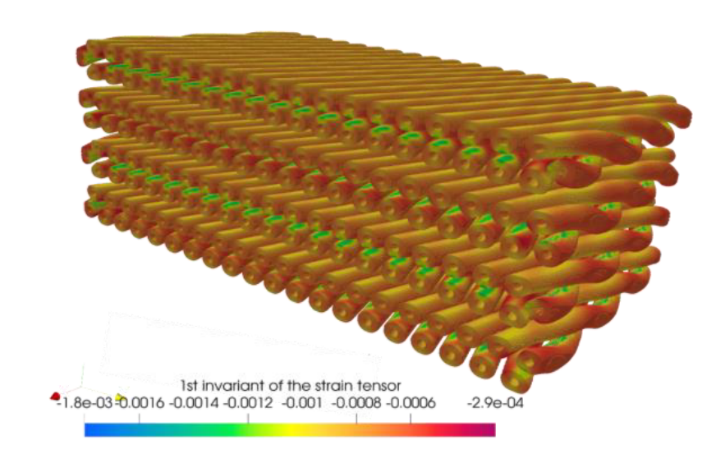Low-temperature superconducting materials are widely used in high-field magnets, but their behaviour is closely related to the strains they undergo. Consequently, studies on the impact of stress on mechanical structures are essential. The SUPRAMITEX project is participating in this research effort by using the AMITEX-FFTP parallel code developed as part of the SIMU/MATIX project to carry out non-linear mechanical simulations on heterogeneous microstructures. This work has shown the interest of the AMITEX code to simulate the mechanical behaviour of these components, at different scales, for elastic and elasto-plastic behaviours at simulation scales that were previously unattainable.
Low-temperature superconducting materials are widely used in high-field magnets for particle accelerators, magnetic resonance imaging systems and nuclear fusion reactors. The implementation of a superconducting cable requires a multi-scale architectural arrangement of the components to ensure that the essential functions of electric current transport and magnetic field generation coexist. These cables are structures of several metres in length whose performance can be played out on the scale of the strand, which has a millimetre dimension. The race towards increasingly high magnetic fields results in an increase in the mechanical stresses exerted on these cables, whose superconducting behaviour is highly dependent on the strains they undergo. With the COCASCOPE project, the DRF/IRFU initiated a multi-scale numerical simulation approach to the mechano-electrical behaviour of cables with a complex Rutherford-type architecture in 2012 (Figure 1).
The SUPRAMITEX project (selected by the CEA's Pole Transverse de Compétence "Numerical Simulation") aimed to evaluate, for this particular application, the interest of using the AMITEX-FFTP parallel code to perform non-linear mechanical simulations on heterogeneous microstructures. Due to the specific geometry presented in figure 1, dedicated discretization/meshing tools of the AMITEX code had to be improved by CEA for this demanding application.
The work carried out within the framework of the CDD of K. Pirapakaran (DRF/IRFU) made it possible to show the interest of the AMITEX code for simulating the mechanical behaviour of these components, at different scales, for elastic and elasto-plastic behaviour. The results obtained were successfully compared with simulations carried out by the CAST3M finite element code. The use of composite voxels (voxels composed of several phases of the microstructure), a specificity of the AMITEX code, has shown its value in limiting the spatial resolution of the calculation. Finally, the efficient parallelism of the code has made it possible to carry out large-scale simulations on cable stacks that were previously unfeasible (Figure 2). This work was highlighted by a presentation at the Applied SuperConductivity 2022 conference and an associated paper [1].
[1] K. Pirapakaran et al., FFT-based approach for the mechanical analysis of superconducting Rutherford-type cables, ASC 2022, Special Issue IEEE Transactions on Applied Superconductivity, DOI 10.1109/TASC.2023.3251289
Contacts: F. Nunio (DRF/Irfu) , P. Manil (DRF/Irfu) , L. Gélébart (DRMP/SRMA), C. Bourcier (DM2S/SGLS)
• Modelisation, calculation and data analysis › Modeling and visualization methods superconducting magnet physics and technology › Instrumentation and development for R&D magnets
• The Systems Engineering Division
• Design, studies and preliminary projects laboratory (LCAP)






